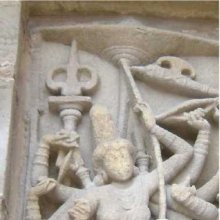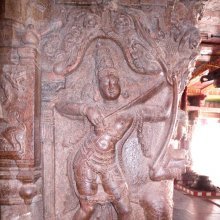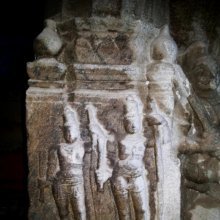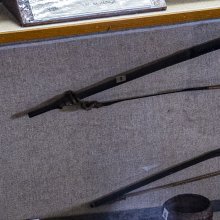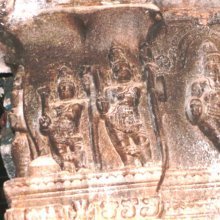Bow and arrow: 2 definitions
Introduction:
Bow and arrow means something in the history of ancient India. If you want to know the exact meaning, history, etymology or English translation of this term then check out the descriptions on this page. Add your comment or reference to a book if you want to contribute to this summary article.
Images (photo gallery)
(+3 more images available)
India history and geography
Source: Singhi Jain Series: Ratnaprabha-suri’s Kuvalayamala-katha (history)Bow and Arrow (as a weapon) was commonly depicted on the Saṃsāracakra paintings (representing scenes of human life), in ancient India, as mentioned in the Kathās (narrative poems) such as Uddyotanasūri in his 8th-century Kuvalayamālā (a Prakrit Campū, similar to Kāvya poetry).—Page 185.21 f.: Here follows a description of a printed scroll illustrating the Jaina conception of saṃsāracakra. [...] The saṃsāra-cakra illustrated the three worlds of hell, human world and the world of gods. [For example:] Persons shooting animals with bow and arrow; a person holding a naked sword and showing feats of swordsmanship; parrots and magpies put in cages for amusement

The history of India traces the identification of countries, villages, towns and other regions of India, as well as mythology, zoology, royal dynasties, rulers, tribes, local festivities and traditions and regional languages. Ancient India enjoyed religious freedom and encourages the path of Dharma, a concept common to Buddhism, Hinduism, and Jainism.
See also (Relevant definitions)
Partial matches: Arrow, Bow, And.
Full-text (+148): Sharabhyasa, Tirakamatha, Dhanuhkanda, Capashara, Dhanushkanda, Atteshukarmuka, Ambugara, Billuvidye, Astri, Seshudhanvan, Astravidye, Ishuvidye, Dhritakarmukeshu, Capaveda, Dhanushka, Ran-awuda, Kodamdapamdita, Anouke, Dhritakarmmukeshu, Dhanukan.
Relevant text
Search found 86 books and stories containing Bow and arrow; (plurals include: Bow and arrows). You can also click to the full overview containing English textual excerpts. Below are direct links for the most relevant articles:
Jnaneshwari (Bhavartha Dipika) (by Ramchandra Keshav Bhagwat)
Folklore of the Santal Parganas
Chapter 21 - The Prince and the Tigress < [Appendix]
Chapter 16 - The Potter’s Son < [Appendix]
Chapter CLXXXIV - The Herd Boy and the Witches < [Part VI]
Harivamsha Purana (by Manmatha Nath Dutt)
Chapter 127 - The Earth Goes to Brahma < [Book 2 - Vishnu Parva]
Chapter 28 - An Account of Raji and His Sons < [Book 1 - Harivamsa Parva]
Chapter 106 - Battle between Pradyumna and Shamvara’s Sons < [Book 2 - Vishnu Parva]
Chapter 10 - The Tournament of Arms < [Adi Parva]
Chapter 4 - Arjuna Vows to Kill Jayadratha < [Drona Parva]
Chapter 7 - Satyaki Follows the Path of Arjuna < [Drona Parva]
Mahabharata (English) (by Kisari Mohan Ganguli)
Section CXXX < [Sambhava Parva]
Section LXXXVI < [Bhagavat-Gita Parva]
Section LXXXI < [Abhimanyu-badha Parva]
Sahitya-kaumudi by Baladeva Vidyabhushana (by Gaurapada Dāsa)
Text 10.192 < [Chapter 10 - Ornaments of Meaning]
Related products
